The 1897-1898 cricket test match films
Late in October 1897 an English test cricket team, captained by Andrew Ernest Stoddart, arrived in Australia. Over the following five months they would play five test matches with the all-Australia test cricket team, several matches with various colonial teams, as well as games with local cricketers around the south-east of the continent. All these matches were, of course, international, but it is important in the following to distinguish between the matches between England and all-Australia, and those between England and a colonial team.
At some of these games motion pictures were taken by various operators. There is little mention of these filming activities in the newspapers of the time, and in no case is a cinematographer identified. Even in Prince Ranjitsinhji's book about the tour, With Stoddart's Team in Australia,1 there is no mention of any cricket activity being filmed (although there are several descriptions of still photographs being taken). Nonetheless, comparisons of the few published references to filming with reports of the various games and reviews of the content of the films enable identification of most of the matches at which the filming took place.
The Lever and Nestlé films
In fact, there was more press attention given in Britain to one group of films
than was given to any in Australia.
The films in question were advertised to have been taken at the first England–Australia
test match, which was played from 13 through 17 December 1897 at the
Sydney Cricket Ground (which until 1894 had been known as the Association Cricket Ground).
There were four films in this set:
The photograph on the right is of Prince (Kumar Shri) Ranjitsinhji, who was an amateur player with the English team and who was an extremely popular figure in his cricket career, enough so to be featured in two of the films. The picture is a detail from a portrait3 taken especially for "Ranji" by Falk and Co., H. Walter Barnett's photographic studios. | 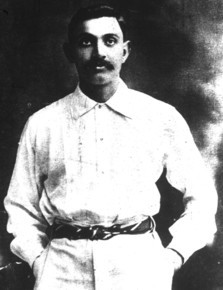
Prince Ranjitsinhji |
The four films were sponsored by a combination (for advertising purposes) of the companies Lever Brothers, of Sunlight soap fame, and Nestlé, of infant food celebrity, and were first shown publicly on 7 February 1898 at the Alhambra Theatre, London, England. As test cricket matches were then still in progress in Australia and were very much in the news in Great Britain, the films were a major success.
There appears to have been a limited showing of them in Australia. Philip Newbury presented them as part of his "Saturday Shilling Pops" shows in Melbourne at the end of May 1898, and in Sydney in October of that year. One may have been shown in Adelaide in July 1899. There are references to other showings of films with Ranji, but it is sometimes not possible to determine if any such film is from the Lever and Nestlé set or is one of the other films mentioned below.
What is known about the films
Each film was made with a Lumière cinématographe (or a copy thereof), as is evidenced by the one-per-frame-side circular sprocket holes visible in the copyright sample frames.
The frame aspect ratio of each film is about 1.25 : 1 (though see the notes below for the second film).
Adjusted and scaled copies of frames provided for copyright registration are shown below.
| 1 | 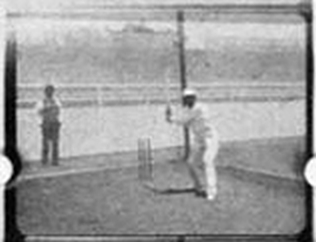
| 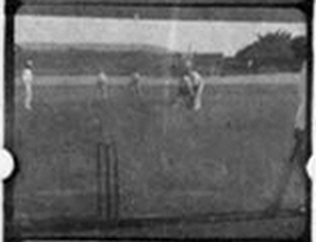
| 2 |
| 3 | 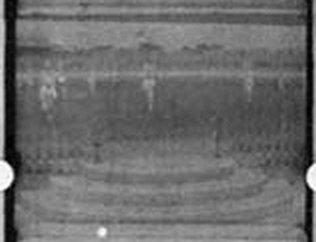
| 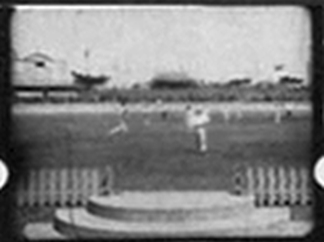
| 4 |
The slightly sloping dark strip at the top of each of frames 1, 2, and 3 is not apparent on frame 4; there is no indication whether this occurred when the films were being taken or when prints of the negatives were being made. It could be due to a misadjustment in the cinématographe mechanism. If it was in the original negatives, it suggests that films 1, 2, and 3 were taken with a different camera from that for film 4; or possibly that the camera was adjusted before film 4 was shot..
1. Prince Ranjitsinhji practising batting at the nets
|
This is the only one of the four films of which a copy is known to survive. The National Film and Sound Archive of Australia has a copy of it as Title no. 623954: PRINCE RANJITSINHJI PRACTISING BATTING AT THE NETS, ASSOCIATION CRICKET GROUND, SYDNEY AUSTRALIA, DEC 1897.
The image on the right is of a frame at about 12.5 seconds into the film
and shows Ranji in position waiting for the delivery of the next ball. In the near background behind the practice nets is what appears to be a light-coloured wall but is in fact the sloping cycle track around the periphery of the playing field.4 It is surmounted by a short picket fence. Behind this is a section of upward-sloping, open land before a high picket fence, one section of which is missing. What may be a bench seat can be seen just inside this farther fence, in the top right of the image. And behind the fence is a small group of trees. Nothing but sky is visible beyond this. No bowler is in frame, and the only time the ball is obviously visible is as a blur on one frame before Ranji's fifth stroke.5 The man wearing a bowler hat standing behind the net behind the stumps remains almost immobile throughout the film. At one point another man briefly runs into frame to pick up the ball. So only three people are seen in the whole film. |
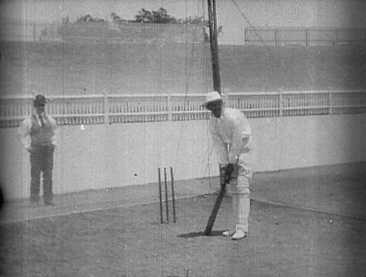
Prince Ranjitsinhji practising batting at the nets |
The frame images provided for copyright registration are laterally reversed: Ranji was a right-handed batsman, as seen in the image above. Also, the copyright frames don't match any frame in one of the YouTube copies of the film, indicating that the film is not complete.
The location for this film is the cricket ground proper. The practice nets were portable and could be set up at a convenient place, possibly chosen to account for the direction of the Sun or the condition of the ground. The shadow of Ranji is short, indicating that the time of filming was around midday, with the Sun roughly to the north: thus the location is somewhere near the southern boundary of the ground. The photograph below shows this southern area about 2 years later, with the cycle track (which again looks like a wall), two fences and sloping ground between them, and it is highly likely that this is where Ranji was practising.

Southern end of SCG, September 18996
Image courtesy of the National Library of Australia
Some of the following notes are taken from the British Film Institute's Film and TV Database entry for the film (with amendments).
The original film is 11.3 m (37 ft) in length,
and plays for about 47 seconds.
The camera is positioned in the silly mid-off area, behind the side netting.
Ranjitsinhji plays the following strokes:
a drive towards extra cover,
a push on the leg side off the front foot,
a pull over mid-wicket,
a drive to extra cover,
a drive to extra cover.
A man comes into the picture to retrieve the ball.
Ranjitsinhji then plays to leg off the back foot,
a square drive,
a pull over mid-on,
a drive to extra cover,
and then moves into position for another drive.
YouTube has several copies of this film, one of which is followed by a version in slow-motion.
2. Prince Ranjitsinhji and Hayward batting and running at the wickets, McKibbin bowling
|
For some reason the copies of the copyright frames are negatives and are
stretched vertically so that the aspect ratio appears to be about 1 : 1,
i.e. square, unlike the other films.
(This is apparent because the stumps appear too long and the sprocket holes look stretched.)7
The camera is positioned behind the wicket at the bowling end, with a clear view to Ranji at the other wicket. The view is roughly to the south, and the long shadows indicate that the film was shot in the afternoon.
| 
Adjusted image of copyright registration frame |
3. English cricket team leaving the field
4. New South Wales cricket team leaving the field
|
The image on the right is from a photograph by Kerry and Co., entitled "The Englishmen take the field", on page 1073 of the 20 November 1897 issue of The Sydney Mail newspaper. Access to the playing field of the Sydney Cricket Ground at that date was by the steps, in front of the Members' Pavilion, to the top, outside edge of the cycle track that was around the periphery of the field. In the copyright proof strips for the 'leaving the field' films – see the sample frames below – these steps and the short paling fence around the outside of the cycle track are clearly visible in the foreground. As can be seen, the films were taken from similar points-of-view, though the camera was higher than for Kerry's photograph.
| 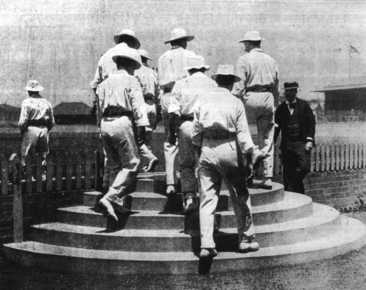
The Englishmen take the field |

| 
|
In the image below the background matches those in the copyright frames. The large structure on the left with the pediment and small black rectangle is the SCG scoreboard.

Intercolonial cricket match – adjourning for lunch, January 18978
Image courtesy of the National Library of Australia
So all four films were shot on or looking on to the playing field of the Sydney Cricket Ground. The critical question now is:
When were the films taken?
Or – at what match or matches were they photographed?
Some points regarding the first England–Australia test match are:
- The match was intended to have been started on Friday, 10 December 1897, but because there had been a lot of rain in Sydney prior to that date it was decided to postpone the game until 11 December; and then a further postponement was made till 13 December. (These postponements were the source of considerable controversy.)
- On the morning of 10 December both the English and Australian teams were at the Sydney Cricket Ground for practice, except that Ranjitsinhji and Hayward (from the English team) were not present. In the afternoon of that day it rained, and there was no further (outdoors) practice.
- Prince Ranjitsinhji had a serious throat infection (quinsy) and it was not certain whether he would be able to play.
- At no time in the match were Ranji and Hayward batting together.
- On 13 December Ranjitsinhji did practise batting before the afternoon's game, but his playing was reported to have been below standard (because of his illness).
- Ranji did not bat on 16 December.
- The last day of the match was 17 December, and England won (by 9 wickets).
- During this match, members of both teams wore black armbands out of sympathy for A. E. Stoddart, whose mother had recently died. Such an obvious detail is not remarked upon in any newspaper report of the films.
- No mention has been found of motion pictures being taken on any day of this match.
Also, no cinematographer would have been allowed on the field during test match play, both for his safety's sake and so as not to interfere with the game. So, without a telephoto (long) lens, any filming of play would have to have been done during practice or a mock game – which must have been the case for film no. 2.
The copyright records for the second, third, and fourth films give
their dates as Decr 10 etc 1897
–
note the etc
.
Presumably, whoever filled out the copyright registration forms was not
up-to-date on the details of the match dates;
as he was also not up-to-date on the name of the cricket ground.
And the copyright record for the fourth film states that it is of
the New South Wales team leaving the field.
But the 13 through17 December match was with the all-Australia team
(which nonetheless did include several New South Wales players).
A report in The Times9 (of London) states that the scenes were filmed on 16 December. In The British Australasian10 two days later, 16 December is also given as the date, and the English team is said to have won the day. The special correspondent for The Advertiser11 (of Adelaide, South Australia) gives a date of 10 December for the film of Ranjitsinhji and Hayward. And this date is repeated in the report in The Era12 of 12 February.
From 12 through 16 November 1897, the English cricket team played the New South Wales colonial team at the Sydney Cricket Ground. The last day of the match was 16 November, and England won. And there were reports of filming the players on this last day:
Some amusement was caused at the conclusion of the match yesterday by a number of the players going on to the field again and putting in some imaginary cricket for the special benefit of the cinematograph, the batsmen being Ranjitsinhji and Hayward, and the bowlers M'Kibbin and Richardson. About a dozen runs were scored, and then the players returned.13and:
A cinematographic picture was taken of the Prince and Hayward batting, Richardson and M'Kibbin bowling, Kelly keeping the wickets, and [Iredale] and Gregory in the field. Two pictures were taken, one while "Ranji" was batting and the other when Hayward was striking.14
These match well this report in The Era of the second film:
The moment chosen for photographing our men batting is when Hayward and Prince Ranjitsinjhi [sic] are in together. Both seem to be playing a very free game, and apparently are doing what they like with the bowling.15
Both Ranji and Hayward had been batting (and were not out) at the end of the match and thus had their pads on, so it would have been little trouble to them to return to the field for filming. It can thus be concluded that the film of them batting – film no. 2 – was made on this occasion – on 16 November 1897.
The Advertiser11 says of this film that
Ranji and Hayward are batting, and the former makes a splendid hit for four.
We see them run it out, [...]
.
Was Hayward seen batting later in the film?
Or, as one of the newspaper reports of the filming (above) states that two films were
taken,
does this imply that a separate film of Hayward was not successfully produced
or not worth presenting?
Also, the English side were fielding at the start of the day's play, and the remaining New South Wales batsmen were dismissed in the first half-hour. So the English team leaving the field (film no. 3) could well have been taken at this point, with the New South Welshmen being filmed leaving at the end of the match (no. 4). This need not be the case, however, and, as pointed out above, film no. 4 may have been taken with a different cinématographe from that used for the other 3 films, and possibly on a different date.
Crucial points about the film of Ranji practising batting are that it was taken about midday (as evidenced by the short shadows), and that no person is seen in the public area behind the fence. (This should be contrasted with the photographs of players in the nets on pages 1072, 1073, and 1076 of The Sydney Mail of 20 November 1897, in the report of the England–New South Wales match.) Ranji may have been privately engaged to perform for this film, and probably on a day when there was no match play (because this started at noon). Furthermore, it is unlikely that the film was taken prior to or during the England–Australia match (in December) because Ranji was ill and was not batting at his best. On Wednesday, 17 November Ranji and McLaren went to the SCG in the morning for "photo"s,16 and this may have been when the film was shot.
To sum up, contrary to how the films were advertised and how they were identified in their copyright records, number 2, and possibly numbers 3 and 4, were taken on 16 November 1897 at the Sydney Cricket Ground, when the visiting English team were playing the New South Wales colonial team. The date of filming Ranji in the nets, film number 1, cannot be determined.
The deception
From the analysis above the conclusion is that at least one (and possibly all) of the cricket films exhibited in London (and elsewhere in Britain) were not what they were claimed to be. And so it has to be asked, who was responsible for this deception, and who knew about it?
The date of the arrival of the films in England, and hence when they left Australia, is important. The four English copyright registrations are dated 1 February 1898 so the films were in England by then. The weekly British show business journal The Era on 29 January published a note announcing that the films would be shown at the Alhambra theatre, London on 7 February, though no specific details of their subjects were given. Thus by 28 January (at the latest) the films were known of in England – though news of them could have arrived by telegraph.
People in Britain would have known roughly how long a trip from Australia to London took, though the variety of available routes results in considerable variation for this duration – about thirty-two days being the minimum from Sydney. The most straightforward journey was by sea all the way; but the various shipping lines stopped at intermediate ports from which the journey could be continued overland; some steamers stopped at Marseille, Naples, or Brindisi, and the onward journey would thence be by rail. Other options were to go to San Francisco or Vancouver and then cross North America before finishing the journey across the Atlantic Ocean.
The departure of the Royal Mail steamer Ophir was probably the very latest that would get the films to London in time – via the Suez Canal. The ship left Sydney on 13 December 1897 and Melbourne on 18 December, and arrived at Plymouth on 27 January 1898 and at London the following day. The R.M.S. Alameda departed from Sydney on 20 December and arrived at San Francisco on 13 January 1898; depending on the transit time from San Francisco to New York, and as it took about 8 days to steam from New York to Liverpool, there is the possibility that the films went this way.
Were the films kept in Australia and sent during or soon after the playing of the England–Australia match, so it appeared to those who received them in England that they were of this match? Or were they sent earlier, and not publicised until enough time had elapsed so it wouldn't be obvious they weren't of the first test? Were one or both of the 'leaving the field' films in fact taken at the December game, so that at least one of their published descriptions was truthful? And did anyone (in Australia or Britain) at the time notice that the films weren't what they were claimed to be? It appears that we are unlikely ever to know.
Who shot these films?
In the copyright record for each of them, "Henry Walter Barnett, Falk Studios, Melbourne [, Australia]" is named as the "Author of Work".17 But H. Walter Barnett was not the cinematographer, because he was not in Australia at the time. He had departed for London on 1 February 189718 and did not return to Australia until 3 March 1903.19 A letter from his friend, the painter Arthur Streeton to him in London can be dated to the last months of 1897,20 thus implying that Barnett was in London (or not far therefrom) at least some of this time. And a note from London with date 10 December 1897 in Melbourne's Punch21 newspaper tells us:
H. W. Barnett (Falk, of Melbourne) has been ill with rheumatism. His many friends will be glad to know he is better and goes to the south of France shortly for the winter.He could not have filmed in Sydney on 16 November and been back in London by 10 December.22
In March 1911 someone using the name "Lafayette" made this statement in Sydney's Bulletin magazine:
[...] The next films made in Australia I took of the English Cricket Team (Ranjitsinghi's [sic] lot), partly in Melbourne and partly in Sydney. These were an order from the Alhambra people, London. [...]23In October 1905 George Austin Brewster and William Henry Hammer, both photographers, opened a photographic studio in Melbourne named Lafayette. (At the time "Lafayette" was the name of a famous Dublin photographic studio, and one was also opened in London.) Nothing has so far been found about either of them having shot a motion picture, nor anything that can prove that either was the "Lafayette" who wrote to the Bulletin. It could have been another employee of the studio; or simply someone who used that name to imply a photographic connection. And this person may have worked for Falk Studios in late 1897.
H. Walter's younger brother, Charles Barnett and their younger (and only) sister, Phoebe Barnett, were also photographers, and apparently working for Falk Studios at the time. Falk's did produce still photographs of some of the English players, including the one of Ranji shown above, so it is quite possible that the cinematographer of the cricket films is Charles or Phoebe. Or it might have been another member of the Falk staff.
Another possibility is Melbourne-based Ernest Jardine Thwaites who, working with Robert William Harvie, had cinematographed the 1897 Melbourne Cup on 2 November, and managed to produce the film of the race for showing on the same evening. As it is the Melbourne branch of Falk Studios that is named on the copyright registrations, possibly Thwaites and Harvie made the cricket films for them.
On 20 August 1898 at the Melbourne Town Hall as part of a variety show
in aid of the East Melbourne Cricket Club, local motion pictures were
exhibited by Messrs. Falk and Co.
, whose operator was Stephen Bond.24
Possibly Bond had taken these pictures, and maybe the cricket films 9 months earlier.
Another candidate for cinematographer is
There is also a report25 in the Adelaide Observer
quoting from an unidentified British source that the operator
(i.e. cinematographer) had been sent to Australia from England.
The Leamington Courier and Warwickshire Standard of 9 April 1898
noted that David Devant sent his cinematograph photographer to Australia
in order to take this set of views.
However, this may just have been exploitation of perceived technological
and cultural supremacy.
Thus the identity or identities of the cinematographer or cinematographers of these films remains a mystery. If who "Lafayette" was could be determined, it would likely clear up this matter.
Other questions
There are further questions about the films and their filming, but most of them can no longer be answered.
- How many films were taken? If more than four what happened to the others? And if only four why not more? And why not of other matches?
- What format(s) of the films were sent to London: the undeveloped negatives, developed negatives, positive prints, or a combination of these? If the negatives were developed, and if prints were made, where was this processing done: Sydney or Melbourne? And by whom? – presumably Falk Studios.
- Were the films dispatched from Sydney or Melbourne? And did they go as unaccompanied cargo or with a passenger?
- Why the delay in having the films shown in Australia? Were there copyright issues?
Other films taken at this series of cricket test matches
(1) The English and Victorian teams played at the Melbourne Cricket Ground
from 6 through 10 November 1897.
In the following month in north-west Tasmania, Colonel Lumare's Cinematographe
and Variety Company showed a film (supposedly) taken at this match.26
In January 1898, in Hobart, Tasmania and nearby, this film was on show.27
From 23 to 25 February, at the Academy of Music, Launceston, Tasmania,
the test match, England v. Australia, taken on the Melbourne Cricket Ground
28
[my emphasis] was part of the programme,
but the film was of the England–Victoria match, as reported in the local paper:
Some very fine scenes were shown by the cinematographe, including [...], also a clear view of the English cricket eleven at present visiting the colonies, which was taken on the Melbourne Cricket Ground on November 9 last. The cricketers were taken as they were proceeding from the pavilion to the reserve.29
On 9 November 1897 the English cricket team went on the field 3 times during the day's play – at the start of Victoria's second innings, after the lunch break, and after the afternoon break – so the filming could have been done on any one of these occasions. Unfortunately, there is no record of it in the major Melbourne newspapers. The cinematographer, whoever he was, could have positioned himself with a view of the way to the field and filmed unobtrusively.
This film is the first film with a cricket theme shot in Australia.
(2) Mark Blow, of the Crown Studios and the Polytechnic, Sydney,
made a film at one of the matches against England.
The first mention of it was on 24 January 1898, when it is referred to
in advertisements as COLONIAL CRICKETERS. FIRST TEST MATCH.
,30
but on the next and subsequent days
it is called AUSTRALIAN CRICKETERS. First Test Match.
.31
On 1 February the advertisement in The Sydney Morning Herald gives
considerable detail:
THE AUSTRALIANS LEAVING THE FIELDAnd a review on 5 February states:
during the First Test Match.
Messrs. Darling, Iredale, M'Leod, Hill, Gregory, Trumble,
Lyons, Trott, Kelly, Jones, and M'Kibbin.
THE TWO ENGLISH BATSMEN,
Ranjitsinhji and M'Laren.32
The newest cinematographe pictures comprise one of the first test cricket match, showing the Australians, Ranjitsinhji, M’Laren, and the umpires going off the field.33
The first England v. all-Australia match finished on 17 December 1897, and the Australian players listed above were those of the Australian team at that match. Also, Ranjitsinhji and McLaren were batting when the score reached a winning value (for the English team) and play stopped. There is no mention of a cinematographe being used at (the end of) the game, but this would appear to be when Blow filmed. If the film simply showed the players and umpires leaving the field, then Blow could have stationed himself with a clear view of the steps to the field and cranked away without being noticed.
(3) The second England v. Australia match was played from 1 to 5 January 1898 at the Melbourne Cricket Ground. On the morning of the first day, advertisements34 proclaimed that on that evening at an entertainment at the Exhibition Building, Melbourne, Ranjitsinhji and A. E. Johns, a Victorian wicketkeeper, would be shown in play by an "Edison cinematographe". Later newspaper reports35,36 mentioned that the tossing of the coin (to decide which captain would choose the team to be first to bat) by Harry Trott and A. C. (Archie) Maclaren, the Australian captain and acting English captain, respectively, had been filmed, as well as Trott batting (though only to demonstrate his technique and not during the match). There was no report of Johns at the wicket and Ranji was still ill and did not want to expend more energy than necessary, so wasn't filmed. The films were presented by Alexander Gunn,36 but it is not known who shot them.
Late in May 1898 advertisements for the Newbury-Spada 'Saturday Shilling "Pops"' concert on 28 May at the Melbourne Town Hall proclaimed (e.g.):
New PICTURES byThere is no other evidence for a film being taken at the fifth England v. Australia test match, which was played on the Sydney Cricket Ground from 26 February through 2 March 1898. It is almost certain that the 4 cricket films advertised were the Lever and Nestlé films, and the one of the English team leaving the field was in fact from the England v. New South Wales match, as noted above. Perhaps stating that it was of the fifth test match made it appear more topical.
THE BIOGRAPHE.
The Sensation of London.
Ranjitsinhji at the nets, Ranji. and Hayward Batting, The English Eleven Leaving the Field, 5th Test Match; The Australian Eleven Leaving the Field, Sydney Test Match; and Hyde Park Corner, London.37
At Carl Hertz's final show in Bombay [Mumbai], India on 25 January 1898 a film or films of Prince Rangitsingji [sic] and Stoddart's team of English cricketers was or were shown at the Novelty Theatre. Which of the above films this was or these were is not known.
References and notes
[1] Prince Ranjitsinhji: With Stoddart's Team in Australia;
James Bowden, London, 1898 (various editions).
[2] The National Archives of the UK (TNA): Public Record Office (PRO) COPY 1/434
Copyright Office: Entry Forms, etc.
The copyright records are dated 1 February 1898,
and Fuerst Brothers of London are the "Proprietor of Copyright".
I have only seen digital images of these, as shown on the Web site of
the National Film and Sound Archive of Australia;
unfortunately the size and quality of these leave a lot to be desired.
[3]
1 January 1898, The Australasian (Melbourne), p.28,
Prince Ranjitsinhji.
and ibid., p.30b,
Cricket Pictures.
[4] I thank Rob La Nauze for convincing me that what is seen is the cycle track (and not a wall). Any detail of the track has been washed out in the digital images. This and further discussion with him inspired the expansion of this article.
[5] Dr Luke McKernan, Curator of Moving Image at the British Library told me that on the film copy the ball can just be discerned on more than one occasion.
[6] 9 September 1899, The Town and Country Journal (Sydney), p.42, The Fort-street Jubilee Demonstration at Sydney Cricket Ground.
[7] This distortion almost certainly occurred when the digital copies of the sample frames were made; it is almost impossible to imagine how it could have happened in 1898.
[8] Detail from
16 January 1897, The Town and Country Journal (Sydney), p.29,
SNAPSHOTS AT THE INTERCOLONIAL CRICKET MATCH, SYDNEY CRICKET GROUND.
A New South Wales team played a South Australian team at the SCG on 8, 9, and 11
February 1897.
(NSW won the match.)
[9] 8 February 1898, The Times (London), p.6b, The Alhambra Theatre.
[10] 10 February 1898, The British Australasian (London), p.309a, Colonial Gossip.
[11] 15 March 1898, The Advertiser (Adelaide), p.6c, English Sporting Notes (dated 11 February 1898).
[12] 12 February 1898, The Era (London), p.[?], Music Hall Gossip.
[13] 17 November 1897, The Sydney Morning Herald, p.8d, International Cricket.
[14] 17 November 1897, The Australian Star (Sydney), p.5c, The Cricket Match; Some Chatty Notes.
[15] 19 February 1898, The Era, p.20a, The London Music Halls.
[16] 17 November 1897, The Australian Star, p.5c, Chat with M'Laren.
[17] Intriguingly, on each form Barnett's name was added later, and in two stages: first "H W Barnett" was written above "Falk Studios"; then "enry" was added (obliquely) to the "H" and "alter" to the "W", because names were required to be written in full. Presumably the legal requirement was that the author's name had to be that of a person and unambiguous. And if this is the case, was H. W. Barnett the only person from Falk Studios whose name was known to whoever filled in the forms? In other words, a name was needed regardless of the veracity of its application.
[18] Letters from Smike: the letters of Arthur Streeton, 1890-1943, pp.70-72;
compiled and edited by Ann Galbally and Anne Gray;
Melbourne, Oxford University Press, 1989.
In a letter to Tom Roberts, Arthur Streeton gives some detail of how he travelled
with Barnett by rail from Melbourne to Adelaide, where they boarded the ship
F.M.S. Polynésien.
[19]
3 March 1903, The Argus (Melbourne), p.5b (news item):
[...] Mr. Barnett has been in London for some six years past, [...]
[20] Mitchell Library, State Library of New South Wales, Sydney:
W. H. Gill papers, vol.14 (Z ML MSS.285/14), frame 69.
Streeton told Barnett not to miss the play The Children of the King
at the Court Theatre, London.
This production ran from 13 October 1897 to early November,
and again, in a revised form, at various dates in December.
(The datestamp is not legible on the microfilm copy of the letter's envelope.)
[21]
20 January 1898, Melbourne Punch, p.57d, Our London Letter.
The National Film and Sound Archive of Australia drew attention to this item in mid-2014.
[22] The information in the Melbourne Punch note does not preclude the (very slight) possibility of Barnett having his bout of rheumatism while on a ship returning from Australia!
[23] 23 March 1911, The Bulletin (Sydney), p.9a, POVERTY POINT
[24] 20 August 1898, The Argus, p.16d, Amusements.
[25] 19 March 1898, Adelaide Observer, p.12, Anglo-Colonial Gossip (dated 11 February 1898)
[26] 9 December 1897, The North-West Post (Formby, Tasmania), p.2e and p.3b.
[27] 25 January 1898, The Mercury (Hobart), p.2h, The Lumare Combination.
[28] 22 February 1898, Launceston Examiner (Launceston, Tasmania), p.6f, Amusements, Cinematographe Company.
[29] 24 February 1898, Launceston Examiner, p.5a, Current Topics, Cinematographe Company.
[30] 24 January 1898, The Sydney Morning Herald, p.2d, Amusements, Polytechnic.
[31] e.g. 25 January 1898, The Sydney Morning Herald, p.2f, Amusements, Polytechnic.
[32] 1 February 1898, The Sydney Morning Herald, p.2a, Amusements, Polytechnic.
[33] 5 February 1898, The Sydney Morning Herald, p.12g, Amusements, Polytechnic.
[34]
1 January 1898, The Age (Melbourne), p.10f,
Amusements;
ibid., p.9d,
Amusements.
[35]
3 January 1898, The Argus, p.5f, The Test Match;
3 January 1898, The Age, p.5g,h, International Cricket.
[36] 3 January 1898, The Age, p.3h, Amusements.
[37] 27 May 1898, The Age, p.8h, AMUSEMENTS., TOWN HALL.
|
Copyright © 2010 – 2020 Tony Martin-Jones | FILM HISTORY INDEX |
Edition 4 (2020-05-10) [First edition in 2010-12] |